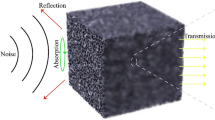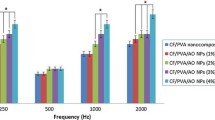Abstract
Noise pollution has become one of the environmental hazards in parallel with air pollution, water pollution, and solid waste pollution worldwide. Cellulose aerogel is a new porous sound-absorbing material that is highly efficient, green, recyclable, and degradable, showing bright prospect for the application in noise suppression. In this study, we fabricated multifunctional acoustic absorptive cellulose nanocrystal (CNC) aerogels by employing calcium chloride as the green crosslinker of CNC, followed by freeze drying. The as-prepared CNC aerogels exhibit excellent broadband acoustic absorption performance with a high maximum absorption coefficient of 0.99 (at 2960 Hz), an average absorption coefficient of 0.85 (in the range of 600–6400 Hz), and a wide absorption bandwidth of 4673 Hz with the absorption coefficient greater than 0.8. The dissipation mechanism of sound energy in the fabricated CNC aerogels is predicted by a designed porous media model. Moreover, good thermal stability, ultralight property (density of 0.036 g/cm3), and high diffuse reflection characteristics (average diffuse reflectance of 98.17% for light) of these CNC aerogels were demonstrated as well. Such versatile aerogel materials not only pave the way for the development of sustainable and efficient acoustic absorption materials, but also have great potential applications in broad fields including construction, transportation, and environment acoustics.








Similar content being viewed by others
Data availability
The data that support the findings of this study are available from the corresponding authors upon reasonable request.
References
Thompson R, Smith RB, Karim YB, Shen C, Drummond K, Teng C, Toledano MB (2022) Noise pollution and human cognition: An updated systematic review and meta-analysis of recent evidence. Environ Int 158:106905. https://doi.org/10.1016/j.envint.2021.106905
Strobach E, Bhatia B, Yang S, Zhao L, Wang EN (2019) High temperature stability of transparent silica aerogels for solar thermal applications. APL Mater 7:081104. https://doi.org/10.1063/1.5109433
Lázaro J, Pereira M, Costa PA, Godinho L (2022) Performance of low-height railway noise barriers with porous materials. Appl Sci 12:2960. https://doi.org/10.3390/app12062960
Tao Y, Ren M, Zhang H, Peijs T (2021) Recent progress in acoustic materials and noise control strategies: a review. Appl Mater Today 24:101141. https://doi.org/10.1016/j.apmt.2021.101141
Cao L, Fu Q, Si Y, Ding B, Yu J (2018) Porous materials for sound absorption. Compos Commun 10:25–35. https://doi.org/10.1016/j.coco.2018.05.001
Zimmermann T, Bordeanu N, Strub E (2010) Properties of nanofibrillated cellulose from different raw materials and its reinforcement potential. Carbohydr Polym 79:1086–1093. https://doi.org/10.1016/j.carbpol.2009.10.045
Wang M, Anoshkin IV, Nasibulin AG, Korhonen JT, Seitsonen J, Pere J, Kauppinen EI, Ras RHA, Ikkala O (2013) Modifying native nanocellulose aerogels with carbon nanotubes for mechanoresponsive conductivity and pressure sensing. Adv Mater 25:2428–2432. https://doi.org/10.1002/adma.201300256
Zhao Y, Zhong K, Liu W, Cui S, Zhong Y, Jiang S (2020) Preparation and oil adsorption properties of hydrophobic microcrystalline cellulose aerogel. Cellulose 27:7663–7675. https://doi.org/10.1007/s10570-020-03309-0
Cai J, Liu S, Feng J, Kimura S, Wada M, Kuga S, Zhang L (2012) Cellulose–silica nanocomposite aerogels by in situ formation of silica in cellulose gel. Angew Chem Int Ed 51:2076–2079. https://doi.org/10.1002/ange.201105730
Lu Y, Sun Q, Yang D, She X, Yao X, Zhu G, Liu Y, Zhao H, Li J (2012) Fabrication of mesoporous lignocellulose aerogels from wood via cyclic liquid nitrogen freezing–thawing in ionic liquid solution. J Mater Chem 22:13548–13557. https://doi.org/10.1039/C2JM31310C
Thai QB, Chong RO, Nguyen PTT, Le DK, Le PK, Phan-Thien N, Duong HM (2020) Recycling of waste tire fibers into advanced aerogels for thermal insulation and sound absorption applications. J Environ Chem Eng 8:104279. https://doi.org/10.1016/j.jece.2020.104279
Do NHN, Luu TP, Thai QB, Le DK, Chau NDQ, Nguyen ST, Le PK, Phan-Thien N, Duong HM (2020) Heat and sound insulation applications of pineapple aerogels from pineapple waste. Mater Chem Phys 242:122267. https://doi.org/10.1016/j.matchemphys.2019.122267
Tran DT, Nguyen ST, Do ND, Thai NTN, Thai QB, Huynh HKP, Nguyen VTT, Phan AN (2020) Green aerogels from rice straw for thermal, acoustic insulation and oil spill cleaning applications. Mater Chem Phys 253:123363. https://doi.org/10.1016/j.matchemphys.2020.123363
Kumar G, Dora DTK, Jadav D, Naudiyal A, Singh A, Roy T (2021) Utilization and regeneration of waste sugarcane bagasse as a novel robust aerogel as an effective thermal, acoustic insulator, and oil adsorbent. J Clean Prod 298:126744. https://doi.org/10.1016/j.jclepro.2021.126744
Moosavi S, Gan S, Chia CH, Zakaria S (2020) Evaluation of crosslinking effect on thermo-mechanical, acoustic insulation and water absorption performance of biomass-derived cellulose cryogels. J Polym Environ 28:1180–1189. https://doi.org/10.1007/s10924-020-01676-0
Lou CW, Zhou X, Liao X, Peng H, Ren H, Li TT, Lin JH (2021) Sustainable cellulose-based aerogels fabricated by directional freeze-drying as excellent sound-absorption materials. J Mater Sci 56:18762–18774. https://doi.org/10.1007/s10853-021-06498-6
Wang Y, Xiang F, Wang W, Wang WL, Su Y, Jiang F, Chen S, Riffat S (2020) Sound absorption characteristics of KGM-based aerogel. Int J Low-Carbon Technol 15:450–457. https://doi.org/10.1093/ijlct/ctaa005
Pu H, Ding X, Chen H, Dai R, Shan Z (2021) Functional aerogels with sound absorption and thermal insulation derived from semi-liquefied waste bamboo and gelatin. Environ Technol Innovation 24:101874. https://doi.org/10.1016/j.eti.2021.101874
Revin VV, Pestov NA, Shchankin MV, Mishkin VM, Platonov VI, Uglanov DA (2019) A study of the physical and mechanical properties of aerogels obtained from bacterial cellulose. Biomacromol 20:1401–1411. https://doi.org/10.1021/acs.biomac.8b01816
Cheng Z, Duan C, Zeng J, Wang B, Xu J, Gao W, Li J, Chen K (2021) Bottom-up ecofriendly strategy for construction of sustainable bacterial cellulose bioaerogel with multifunctional properties. Adv Mater Interfaces 8:2002101. https://doi.org/10.1002/admi.202002101
Chen W, Li Q, Wang Y, Yi X, Zeng J, Yu H, Liu Y, Li J (2014) Comparative study of aerogels obtained from differently prepared nanocellulose fibers. Chemsuschem 7:154–161. https://doi.org/10.1002/cssc.201300950
Fan B, Yao Q, Wang C, Jin C, Wang H, Xiong Y, Li S, Sun Q (2017) Natural cellulose nanofiber extracted from cell wall of bamboo leaf and its derived multifunctional aerogel. Polym Compos 39:3869–3876. https://doi.org/10.1002/pc.24419
NNT Thai QND Chau ND Do TD Tran HKP Huynh AT Nguyen XY Goh VTT Nguyen H Nguyen AN Phan ST Nguyen 2021 Fabrication of cellulose-based aerogel for thermal and acoustic insulation applications IOP Conf Ser: Earth Environ Sci 947 012030 https://doi.org/10.1088/1755-1315/947/1/012030
He C, Huang J, Li S, Meng K, Zhang L, Chen Z, Lai Y (2018) Mechanically resistant and sustainable cellulose-based composite aerogels with excellent flame retardant, sound-absorption, and superantiwetting ability for advanced engineering materials. ACS Sustainable Chem Eng 6:927–936. https://doi.org/10.1021/acssuschemeng.7b03281
Hafez I, Tajvidi M (2021) Comprehensive insight into foams made of thermomechanical pulp fibers and cellulose nanofibrils via microwave radiation. ACS Sustainable Chem Eng 9:10113–10122. https://doi.org/10.1021/acssuschemeng.1c01816
Zhu G, Xu H, Dufresne A, Lin N (2018) High-adsorption, self-extinguishing, thermal and acoustic resistance aerogels based on organic and inorganic waste valorization from cellulose nanocrystals and red mud. ACS Sustainable Chem Eng 6:7168–7180. https://doi.org/10.1021/acssuschemeng.8b01244
Feng J, Le D, Nguyen ST, Nien VTC, Jewell D, Duong HM (2016) Silica–cellulose hybrid aerogels for thermal and acoustic insulation applications. Colloid Surface A 506:298–305. https://doi.org/10.1016/j.colsurfa.2016.06.052
Lefebvre J, Leblanc A, Genestie B, Chartier T, Lavie A (2016) Acoustic properties of aerogel encapsulated by macroporous cellulose. 23rd International Congress on Sound and Vibration. https://www.researchgate.net/publication/306917581
Silviana S, Hermawan F, Indracahya J, Kusumawardhani DAL, Dalanta F (2022) Optimizing the environmentally friendly silica-cellulose aerogel composite for acoustic insulation material derived from newspaper and geothermal solid waste using a central composite design. J Sol-Gel Sci Technol 103:226–243. https://doi.org/10.1007/s10971-022-05831-y
Pinto SC, Silva NHCS, Pinto RJB, Freire CSR, Duarte I, Vicente R, Vesenjak M, Marques PAAP (2020) Multifunctional hybrid structures made of open-cell aluminum foam impregnated with cellulose/graphene nanocomposites. Carbohydr Polym 238:116197. https://doi.org/10.1016/j.carbpol.2020.116197
Shen L, Zhang H, Lei Y, Chen Y, Liang M, Zou H (2021) Hierarchical pore structure based on cellulose nanofiber/melamine composite foam with enhanced sound absorption performance. Carbohydr Polym 255:117405. https://doi.org/10.1016/j.carbpol.2020.117405
Cao L, Yu X, Yin X, Si Y, Yu J, Ding B (2021) Hierarchically maze-like structured nanofiber aerogels for effective low-frequency sound absorption. J Colloid Interface Sci 597:21–28. https://doi.org/10.1016/j.jcis.2021.03.172
Zhou S, Guo K, Bukhvalov D, Zhang XF, Zhu W, Yao J, He M (2020) Cellulose hydrogels by reversible ion-exchange as flexible pressure sensors. Adv Mater Technol 5:2000358. https://doi.org/10.1002/admt.202000358
Zhang XF, Ma X, Hou T, Guo K, Yin J, Wang Z, Shu L, He M, Yao J (2019) Inorganic salts induce thermally reversible and anti-freezing cellulose hydrogels. Angew Chem Int Ed 58:7366–7370. https://doi.org/10.1002/anie.201902578
Zhang X, Hou T, Chen J, Feng Y, Li B, Gu X, He M, Yao J (2018) Facilitated transport of CO2 through the transparent and flexible cellulose membrane promoted by fixed-site carrier. ACS Appl Mater Interfaces 10:24930–24936. https://doi.org/10.1021/acsami.8b07309
Xu Q, Chen C, Rosswurm K, Yao T, Janaswamy S (2016) A facile route to prepare cellulose-based films. Carbohydr Polym 149:274–281. https://doi.org/10.1016/j.carbpol.2016.04.114
Rao AP, Rao AV, Pajonk GM (2007) Hydrophobic and physical properties of the ambient pressure dried silica aerogels with sodium silicate precursor using various surface modification agents. Appl Surf Sci 253:6032–6040. https://doi.org/10.1016/j.apsusc.2006.12.117
Guo H, Nguyen BN, McCorkle LS, Shonkwiler B, Meador MAB (2009) Elastic low density aerogels derived from bis[3-(triethoxysilyl)propyl]disulfide, tetramethylorthosilicate and vinyltrimethoxysilane via a two-step process. J Mater Chem 19:9054–9062. https://doi.org/10.1039/B916355G
Matias T, Varino C, Sousa HC, Braga MEM, Portugal A, Coelho JFJ, Durães L (2016) Novel flexible, hybrid aerogels with vinyl and methyltrimethoxysilane in the underlying silica structure. J Mater Sci 51:6781–6792. https://doi.org/10.1007/s10853-016-9965-9
Han T, Wang X, Xiong Y, Li J, Guo S, Chen G (2015) Light-weight poly(vinyl chloride)-based soundproofing composites with foam/film alternating multilayered structure. Compos A 78:27–34. https://doi.org/10.1016/j.compositesa.2015.07.013
Qin Q, Guo R, Ren E, Lai X, Cui C, Xiao H, Zhou M, Yao G, Jiang S, Lan J (2020) Waste cotton fabric/zinc borate composite aerogel with excellent flame retardancy. ACS Sustain Chem Eng 8:10335–10344. https://doi.org/10.1021/acssuschemeng.0c00210
Allard JF, Atalla N (2009) Propagation of sound in porous media: modelling sound absorbing materials, 2nd edn. Wiley, New York
Kuczmarski MA, Johnston JC (2011) Acoustic absorption in porous materials. NASA/TM-2011–216995. https://ntrs.nasa.gov/citations/20110011143
Soltani P, Taban E, Faridan M, Samaei SE, Amininasab S (2020) Experimental and computational investigation of sound absorption performance of sustainable porous material: Yucca Gloriosa fiber. Appl Acoust 157:106999. https://doi.org/10.1016/j.apacoust.2019.106999
Horoshenkov KV, Groby JP, Dazel O (2016) Asymptotic limits of some models for sound propagation in porous media and the assignment of the pore characteristic lengths. J Acoust Soc Am 139:2463–2474. https://doi.org/10.1121/1.4947540
Horoshenkov KV, Hurrell A, Groby JP (2019) A three-parameter analytical model for the acoustical properties of porous media. J Acoust Soc Am 145:2512–2517. https://doi.org/10.1121/1.5098778
Hu L, Zheng G, Yao J, Liu N, Weil B, Eskilsson M, Karabulut E, Ruan Z, Fan S, Bloking JT, McGehee MD, Wågberg L, Cui Y (2013) Transparent and conductive paper from nanocellulose fibers. Energy Environ Sci 6:513–518. https://doi.org/10.1039/C2EE23635D
Wu ZY, Li C, Liang HW, Chen JF, Yu SH (2013) Ultralight, flexible, and fire-resistant carbon nanofiber aerogels from bacterial cellulose. Angew Chem 125:2997–3001. https://doi.org/10.1002/ange.201209676
Acknowledgements
This work was supported by the Yunnan Fundamental Research Projects (Grant Nos. 202201AU070036, 202101BA070001-175, and 202101BA070001-162), the National Natural Science Foundation of China (Grant Nos. 52261009 and 12165010), the Science Foundation of the National Laboratory of Solid State Microstructures, the Science Foundation of Kunming University (Grant No. YJL20014), the Key Laboratory of Artificial Microstructures in Yunnan Higher Education Institutions, the Program for Innovative Research Team in Kunming University, and the Cooperation Program of XDU-Chongqing IC Innovation Research Institute (Grant No. CQIRI-2022CXY-Z07).
Author information
Authors and Affiliations
Contributions
JQR and QYC contributed to conceptualization and design; all authors were involved in data curation and formal analysis; investigation and methodology; and manuscript writing and editing; JQR, WG, and XZ contributed to funding acquisition; and JQR, CF, and MHL were involved in project administration and supervision.
Corresponding authors
Ethics declarations
Conflict of interest
The authors declare that they have no conflict of interest.
Additional information
Handling Editor: Stephen Eichhorn.
Publisher's Note
Springer Nature remains neutral with regard to jurisdictional claims in published maps and institutional affiliations.
Supplementary Information
Below is the link to the electronic supplementary material.
Rights and permissions
Springer Nature or its licensor (e.g. a society or other partner) holds exclusive rights to this article under a publishing agreement with the author(s) or other rightsholder(s); author self-archiving of the accepted manuscript version of this article is solely governed by the terms of such publishing agreement and applicable law.
About this article
Cite this article
Ruan, JQ., Xie, KY., Li, Z. et al. Multifunctional ultralight nanocellulose aerogels as excellent broadband acoustic absorption materials. J Mater Sci 58, 971–982 (2023). https://doi.org/10.1007/s10853-022-08118-3
Received:
Accepted:
Published:
Issue Date:
DOI: https://doi.org/10.1007/s10853-022-08118-3




